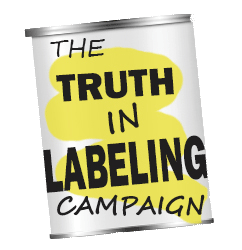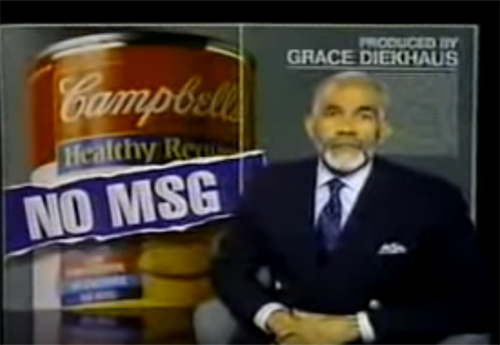The myth that MSG is a harmless food additive that can trigger a limited number of insignificant reactions was launched in 1968 when the New England Journal of Medicine carried a letter from Dr. Ho Man Kwok that the journal titled Chinese Restaurant Syndrome. Glutamate industry agents hyped the fact that Kwok reported minor reactions to food eaten in a Northern-Chinese restaurant. And the myth was propelled forward along an unmuddied path as the myriad of scientific studies done in the 1970s showing MSG-induced brain damage, obesity, and infertility were suppressed, and all reactions other than those mentioned in Kwok’s letter were denied.
Myth: Monosodium glutamate (MSG) is a harmless food additive. Scientific research has shown that MSG is a harmless food additive because study after study have failed to show that MSG causes adverse reactions.
Fact 1: The studies cited by the Glutes as evidence of MSG safety are studies in which MSG was fed to volunteers who were given test material containing MSG at one time, and at another time given a placebo that contained (without disclosure) an excitotoxic amino acid — one that would trigger the exact same reactions as those caused by MSG. When subjects reacted to both test material and placebo, which they did, researchers claimed to have again failed to demonstrate MSG toxicity. More on this subject can be found at https://www.truthinlabeling.org/flawed.html.
Fact 2: Studies showing MSG-induced brain damage were challenged by the Glutes in the 1970s, but the challenges were refuted. Now, MSG-induced brain damage is never mentioned by industry.
Myth: The FDA has investigated some of the claims of reactions to MSG and has never been able to confirm that the additive caused the reported effects.
Fact: By law, the FDA is required to investigate claims of serious reactions to the products they regulate, but they rarely do so. The reports of at least two FDA investigators who examined reports of serious reactions following ingestion of MSG did not reflect the data that had been given them by the persons reacting to MSG or by their physicians. More on this subject can be found at https://www.truthinlabeling.org/assets/it_wasnt_az.pdf.
Myth: The FDA commissioned a group of independent scientists from the Federation of American Societies for Experimental Biology (FASEB) to examine the safety of MSG in the 1990s, and FASEB determined that MSG is safe.
Fact: At least 3 of the alleged “independent” scientists had clear-cut conflicts of interest.
Myth: The extensive body of research which exists about glutamate has been reviewed by independent scientists and regulatory authorities around the world — all have found MSG to be safe.
Fact: The scientific authorities from around the world often cited by the Glutes, (which included the Federation of American Societies for Experimental Biology (FASEB), the United Nations World Health Organization/Food and Agriculture Organization’s Joint Expert Committee on Food Additives (JECFA), the European Communities’ (EC) Scientific Committee for Food, and the Council on Scientific Affairs of the American Medical Association) considered only those documents submitted to them by Ajinomoto’s International Glutamate Technical Committee (IGTC) or their agents, or their glutamate-industry friends at the FDA.
Myth: MSG is made from corn starch, sugar cane, sugar beets or molasses by a natural method that has been used for centuries. This is known as the fermentation process. It is similar to how wine, beer, vinegar and yogurt are made.
Fact: In 1956, the Japanese succeeded in producing glutamic acid by means of bacterial fermentation, and after considerable research to identify suitable strains of microorganisms for starting the requisite cultures, large-scale production of glutamic acid and monosodium glutamate through fermentation began. In this fermentation process, genetically modified bacteria are grown aerobically in a liquid nutrient medium. These bacteria have the ability to synthesize glutamic acid outside of their cell membranes and excrete it into the medium to accumulate there.
This is a new process, not one used over centuries. And certainly not how wine, beer, vinegar and yogurt are made.
Myth: The glutamate in unprocessed/ unadulterated/ unfermented protein is the same as the glutamate in MSG. The glutamate that naturally occurs in many foods and the glutamate added in monosodium glutamate (MSG) are exactly the same.
Fact 1: The glutamate found in unprocessed/unadulterated/unfermented protein is L-glutamate only. Whereas MSG used in cosmetics, drugs, vaccines, dietary supplements, and processed food is manufactured, and always contains L-glutamate plus D-glutamate (an unwanted byproduct of L-glutamate production) plus other unwanted by-products of production that industry calls impurities. And since industry has not found a way to remove the unwanted impurities from processed free L-glutamate, the glutamate in MSG always comes with impurities.
Fact 2: It is glutamic acid that has been manufactured that causes brain damage and adverse reactions. Glutamic acid found in unadulterated protein causes neither brain damage nor adverse reactions.
Myth: There is no difference between the toxicity of food that is high in glutamate, and processed food that contains MSG.
Fact: Food that is unprocessed, unadulterated and unfermented, no matter how much glutamate it contains will not cause adverse reactions in MSG-sensitive people. Food that contains MSG will cause MSG-reactions in MSG-sensitive people if the amounts ingested exceed individual tolerances for MSG.
Myth: Monosodium glutamate has been in use for over 2,000 years.
Fact: Monosodium glutamate was invented in 1908 and reformulated in 1957.
Myth: The reactions to monosodium glutamate are mild and transitory.
Fact: Asthma, migraine headache, depression, atrial fibrillation, tachycardia, and seizures are just a few of the abnormalities known to be triggered by MSG.
Myth: The glutamic acid in monosodium glutamate is identical to the glutamic acid in unadulterated protein.
Fact: Glutamic acid found naturally in protein is L-glutamic acid, only. Glutamic acid in MSG, i.e., processed/manufactured glutamic acid, is always made up of both L-glutamic acid and D-glutamic acid, and is always accompanied by impurities in addition to the D-glutamic acid that is invariably produced when attempts are made to produce L-glutamic acid.
Myth: No one reacts to less than 3 grams of MSG.
Fact: Published studies by Scopp and Allen and hundreds of comments by MSG-sensitive people affirm that less than 3 grams of MSG may cause reactions.
Myth: Reactions to MSG occur within 10 minutes of ingesting MSG and last for less than 2 hours.
Fact: Reactions to MSG have been known to occur as long as 48 hours after ingestion and last for days.
Myth: MSG is naturally occurring.
Fact 1: By FDA definition, arsenic and hydrochloric acid would be “naturally occurring” along with MSG. Industry gets mileage from talking about MSG being “naturally occurring.” And the FDA cooperates by refusing to define the term.
Fact 2: In the United States, MSG is manufactured in Ajinomoto’s plant in Eddyville Iowa. MSG is a product of manufacture. It doesn’t occur naturally anywhere or in anything.
Myth: The blood brain barrier protects the brain from excesses of monosodium glutamate.
Fact: The blood brain barrier, once thought to prevent glutamate from sources outside of the body from entering the brain, is not fully developed until puberty, is easily damaged by such conditions as high fever, a blow to the head, and the normal course of aging. In the area of the circumventricular organs (which includes the area of brain damaged by MSG), it is leaky at best during any stage of life.
The brains of the young are most at risk from ingestion of MSG. More on this subject can be found at https://www.truthinlabeling.org/young.html.
If you have questions or comments, we’d love to hear from you. If you have hints for others on how to avoid exposure to MfG, send them along, too, and we’ll put them up on Facebook. Or you can reach us at questionsaboutmsg@gmail.com and follow us on Twitter @truthlabeling.






